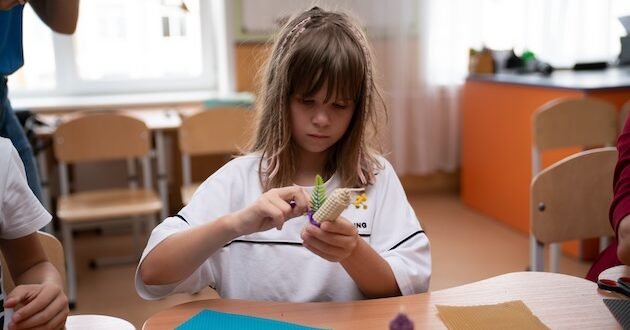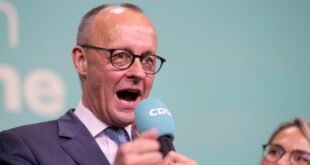
KYIV Kyiv & NAIROBI, Sep 13 (IPS) – In a major escalation of a conflict that started in 2014 and which is the largest in Europe since World War II, Russia invaded Ukraine in February 2022. Since then, thousands of Ukrainian civilians—many of them women and children—have lost their lives. Countless others have been displaced from their homes, clinging to what remains of the education system as their communities disintegrate.
On a high-level UN mission to Ukraine this week, Education Cannot Wait (ECW)—the global fund for education in emergencies and protracted crises within the United Nations—met with children affected by the war and local partners. The mission took stock of the impact of the conflict on approximately 4 million children across Ukraine whose schooling has been severely disrupted.
“We visited a school in Kyiv, where classes continue despite the constant threat of attack. Alarms frequently signal imminent danger. The school has a bomb shelter for 500 children, but there are over 1,000 students enrolled. To ensure everyone has access to the shelter when needed, primary school children attend in the morning, and secondary school children attend in the afternoon,” Yasmine Sherif, ECW’s Executive Director, told IPS.
“We also spoke with psychologists and parents, including single mothers displaced from the east, north, and south of the country. They’ve come to Kyiv, leaving behind the fathers and grandparents of their children. We were able to see how a strong focus on mental health and social services is helping children and families cope with these challenges, with excellent collaboration between teachers, psychologists, parents, and the broader community. The Ministry of Education is working tirelessly to ensure safe learning environments for all children,” Sherif added.

According to Sherif, children in Ukraine continue their education in core subjects like reading and mathematics, alongside arts education, even under these difficult circumstances. ECW was among the first to invest in education in Ukraine, starting in 2017, with an initial emergency response supporting children along the front lines in eastern Ukraine.
Since then, ECW has provided USD 27 million in funding to support quality, holistic education programmes in Ukraine since 2017. As conflict continues to escalate and education needs multiply, ECW has received much-needed donations from additional donors, including Germany and Japan, to support education in Ukraine.
At last year’s Education Cannot Wait High-Level Financing Conference, the Global Business Coalition for Education pledged to mobilize USD 50 million from the business community to support ECW’s four-year strategic plan. In partnership with GBCE, TheirWorld, HP and Microsoft, USD 39 million in partnership and device donation for ECW has already been mobilized, and over 70,000 laptops have been shared with schools, teachers and other people in need, both inside Ukraine and in neighboring countries.
This is a huge investment in expanding educational opportunities for children who are unable to access in-person learning. Delivered by a consortium of partners including Finn Church Aid, the Kyiv School of Economics, Save the Children and UNICEF—in coordination with Ukraine’s Ministry of Education and Science—ECW’s education programmes have thus far reached more than 360,000 children, about 65 percent of whom are girls.

Against this backdrop, Munir Mammadzade, UNICEF Representative to Ukraine, emphasized that the “support from Education Cannot Wait is critical for children, their parents and teachers who are doing everything they can to keep classrooms open and to continue in-person learning despite the impact of the war across the country.”
However, more funding is urgently needed. Over 1,300 educational facilities have been damaged or destroyed, and nearly 600,000 children remain unable to access in-person learning since the start of the school year in early September, due to ongoing deadly and destructive fighting, attacks and displacement.
“This atrocious war must stop now! For as long as the children, adolescents and teachers in Ukraine suffer this unfathomable horror, schools must be protected from attacks. As a global community, we must rise to the challenge before us to ensure that every girl and every boy in Ukraine impacted by this brutal war and the refugees have access to the safety, hope and opportunity that only a quality education can provide,” Sherif said.
ECW and its strategic partners are calling for USD 600 million in additional funding from private and public donors to deliver on the global targets outlined in the Fund’s 2023-2026 Strategic Plan. This funding would provide 20 million children in crisis-impacted countries around the globe with safe, inclusive, and quality education, and the hope for a better tomorrow.

According to Sherif, ECW’s investment in education is an investment in recovery, peace, security, and justice for Ukraine and beyond. It is an investment in the vast potential of future generations. Earlier this year, ECW announced an USD 18 million allocation to roll out a Multi-Year Resilience Programme in Ukraine. The investment aims to raise an additional USD 17 million to reach over 150,000 children across 10 of the country’s most affected areas.
The programme aims to improve learning outcomes in safer, more accessible environments while expanding digital learning options as an alternative. There is also a strong emphasis on mental health, psychosocial support, and targeted assistance for girls and children with disabilities.
The UN high-level mission concluded at the Fourth Summit of First Ladies and Gentlemen, where ECW called on world leaders to commit to protecting education from attack and to scale up funding to provide life-saving access to safe education, both in-person and through remote learning opportunities, when necessary, as well as catch-up classes for children who have fallen behind.
IPS UN Bureau Report
Follow @IPSNewsUNBureau
Follow IPS News UN Bureau on Instagram
© Inter Press Service (2024) — All Rights ReservedOriginal source: Inter Press Service

